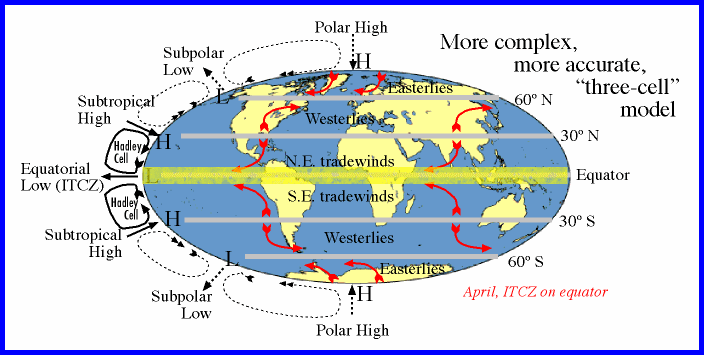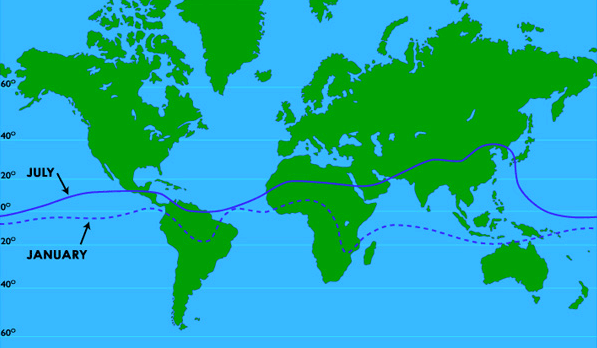- Near the equator, from about 5° north and
5° south, the northeast trade winds and southeast trade winds
converge in a low pressure zone known as the
Intertropical Convergence Zone or ITCZ.

- Solar heating in the region forces air to
rise through convection which results in a plethora of precipitation. The ITCZ is a key component of
the global circulation system.
- Weather stations in the equatorial region
record precipitation up to 200 days each year, making the equatorial and ITC zones the
wettest on the planet. The equatorial region lacks a dry season and is
constantly hot and humid.
- The location of the ITCZ varies throughout
the year and while it remains near the equator, the
ITCZ over land ventures farther north or south than the ITCZ over the
oceans due to the variation in land temperatures.
- The location of the ITCZ can vary as much as
40° to 45° of latitude north or south of the equator based on the pattern
of land and ocean.
- In Africa, the ITCZ is located just south
of the Sahel at about 10°, dumping rain on the region to the south of the
desert.
- The Intertropical Convergence Zone has
been called the doldrums by sailors due to the lack of
horizontal air movement (the air simply rises with convection). The ITCZ
is also known as the Equatorial Convergence Zone or Intertropical Front.
- There's a diurnal cycle to the
precipitation in the ITCZ. Clouds form in the late morning and early afternoon
hours and then by 3 to 4 p.m., the hottest time of the day, convectional
thunderstorms form and precipitation begins. These storms are generally
short in duration.
-Why do Doldrums occur ?- In the Intertropical Convergence Zone, the northern and southern trade winds come together.
- Because of the rotation of the Earth, the winds cannot
really cross the equator without losing energy.
- Instead of continuing over the Earth horizontally, the
winds thus move vertically toward the upper atmosphere.
- The heating of the Earth's ocean currents by the sun
assists in this process, making the air warmer and letting it rise.
- The result is that the Intertropical Convergence Zone
has low air pressure near the Earth's surface.
- The lack of horizontal wind movement in the region
caused sailors to nickname the Intertropical Convergence Zone, "the
doldrums."
*-*-*-*-*-*-*-*-*-*-*-*-*-*-*-*-*-*-*-*-*-*-*-*-*-*-*-*-*-*-*-*-*-*-*-*-*-*-*-*-*-*-*-*Why do Thuderstorms occur in ITCZ ?

- Solar heating in the region forces air to
rise through convection which results in a plethora of precipitation. The ITCZ is a key component of
the global circulation system.
- Rainfall in the Intertropical Convergence Zone typically
is not gentle rainfall that lasts for long periods.
- Instead, the high amounts of energy from
thermal and solar heating cause moisture to condense quickly into clouds
in the hottest part of the day.
- Circular typhoons thus often form as the air currents
move. Some of the strongest winds on the Earth have been recorded in these
storms.
- Thunderstorms with heavy lightening also are common.
Why do ITCZ do not have a consistent location ?- The Intertropical Convergence Zone is characterized by
inconsistent location around the equator.
- As the Earth moves with the seasons, the area which
receives the highest amount of heat energy from the sun varies.
- The thermal equator around which the Intertropical
Convergence Zone forms thus moves, depending on the season.
- In some cases, this shift can result in the complete
reversal of normal trade wind patterns, particularly in the Indian Ocean.

*-*-*-*-*-*-*-*-*-*-*-*-*-*-*-*-*-*-*-*-*-*-*-*-*-*-*-*-*-*-*-*-*-*-*-Role of ITCZ in monsoons ?- Inter Tropical Convergence Zone (ITCZ) The
Inter Tropical Convergence Zone (ITCZ) is a low pressure zone located at
the equator where trade winds converge, and so, it is a zone where air
tends to ascend.
- In July, the ITCZ is located around 20ºN
latitudes (over the Gangetic plain), sometimes called the monsoon trough.
- This monsoon trough encourages the
development of thermal low over north and northwest India.
- Due to the shift of ITCZ, the trade winds
of the southern hemisphere cross the equator between 40ºE and 60ºE
longitudes and start blowing from southwest to northeast due to the
Coriolis force. It becomes southwest monsoon.
- In winter, the ITCZ moves southward, and
so the reversal of winds from northeast to south and southwest, takes
place. They are called northeast monsoons.
*-*-*-*-*-*-*-*-*-*-*-*-*-*-*-*-*-*-*-*-*-*-*-*-*-*-*-*-*-*-*-*-*-*-*-*-*-*-*-- Rainfall in the Intertropical Convergence Zone typically
is not gentle rainfall that lasts for long periods.

